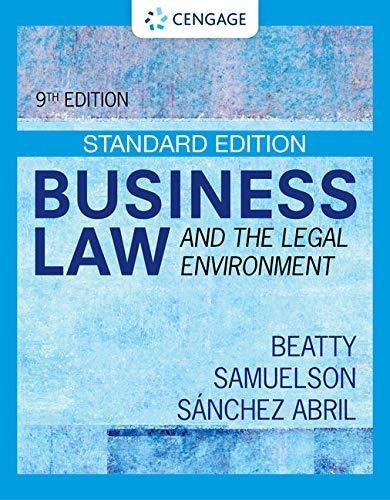Question
Question 1: The concept of dual-sovereignty a) Places limits on federal power. b) Places limits on state power. c) Gives the federal government twice the
Question 1: The concept of dual-sovereignty
a) Places limits on federal power.
b) Places limits on state power.
c) Gives the federal government twice the power as state government.
d) Answers a and b.
Question 2: State powers are
a) Noted in the United States Constitution in the 10th
Amendment.
b) Protected by the Supreme Court with the traditional state government function test.
c) Superior to federal power.
d) All of the above
Question 3: In Garcia v. San Antonio Municipal Transit Authority, the Court
a) Ruled that the federal Fair Labor Standards Act could not be applied to states.
b) Ruled that Congress did not have the authority to enact the Fair Labor Standards Act.
c) Ruled that the traditional state government function test was unworkable.
d) Ruled that paying employees minimum wage was a traditional state government function.
Question 4: In New York v. United States, the Court
a) Ruled that the federal government may commandeer states to enforce federal laws.
b) Ruled that the federal government may commandeer states to implement federal programs.
c) Ruled that the federal government cannot commandeer states to comply with state laws.
d) Ruled that the federal government cannot commandeer states to enforce or implement federal laws.
Notes:
- The federal government cannot commandeer a state into enacting a certain law.
Question 5: In Reno v. Condon, the Court ruled that
a) Congress did not have the power under the Commerce Clause to pass a law that prohibited states from selling personal information about drivers.
b) Congress cannot commandeer states to stop selling personal information about drivers.
c) Congress may require states to stop selling personal information about drivers.
d) Congress may require states to sell personal information about drivers.
Question 6: Which of the following would be constitutional?
a) Congress offers states federal funds under the Spending Clause to enact state laws and enforce existing federal laws regarding patient safety in hospitals.
b) Congress requires states to enact state laws and enforce existing federal laws regarding patient safety in hospitals under the Commerce Clause.
c) Congress requires states to implement existing federal laws regarding patient safety in hospitals under the Commerce Clause.
d) All of the above.
Question 7: Which of the following is true regarding the Gregory v. Ashcroft decision?
a) Congress may not enact laws that upset the constitutional balance of federal and state powers.
b) A federal law must have a plain statement indicating congressional intent to apply if it could alter the constitutional balance of federal and state powers.
c) A federal law must not have a plain statement indicating congressional intent to apply if it could alter the constitutional balance of federal and state powers.
d) States do not have to comply with laws that upset the constitutional balance of federal and state powers.
Step by Step Solution
There are 3 Steps involved in it
Step: 1

Get Instant Access to Expert-Tailored Solutions
See step-by-step solutions with expert insights and AI powered tools for academic success
Step: 2

Step: 3

Ace Your Homework with AI
Get the answers you need in no time with our AI-driven, step-by-step assistance
Get Started


